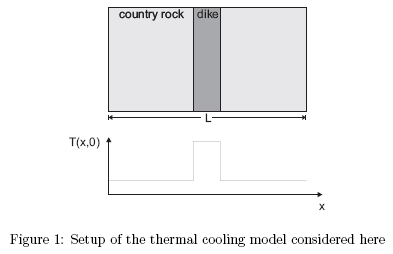Question
[numerical analysis] Consider the one-dimensional, heat equation , where rho is density, c_p heat capacity, k thermal conductivity, T temperature, x distance and t time.
[numerical analysis] Consider the one-dimensional, heat equation  , where rho is density, c_p heat capacity, k thermal conductivity, T temperature, x distance and t time.
, where rho is density, c_p heat capacity, k thermal conductivity, T temperature, x distance and t time.
If the thermal conductivity, density and heat capacity are constant over the model domain, the equation can be simplified to
 where
where  is the thermal diffusivity (a common value for rocks is
is the thermal diffusivity (a common value for rocks is  ).
).
We are interested in the temperature evolution versus time, T(x,t), givene an initial temperature distribution Fig 1.
An example would be the intrusion of a basaltic dike in cooler country rocks.
The country rock has a temperature of 300(Celsius) and the dike a total width W = 5m, with a magma temperature of 1200(Celsius).
In addition we assume that the temperature far away from the dike center (at L/2 where L = 100m) remains at a constant temperature, 300(Celsius)

Let the  be maximum temperature of dike when time is t.
be maximum temperature of dike when time is t.
Plot  graph by using natural cubic spline interpolation
graph by using natural cubic spline interpolation
Find the time t1 and  by using bisection, Newton's method or secant method
by using bisection, Newton's method or secant method
Please use Matlab or Python
8? 8 , , ?? p?p ?t = ar * or 8? 8 , , ?? p?p ?t = ar * or
Step by Step Solution
There are 3 Steps involved in it
Step: 1

Get Instant Access to Expert-Tailored Solutions
See step-by-step solutions with expert insights and AI powered tools for academic success
Step: 2

Step: 3

Ace Your Homework with AI
Get the answers you need in no time with our AI-driven, step-by-step assistance
Get Started


